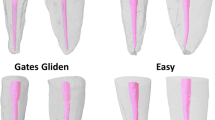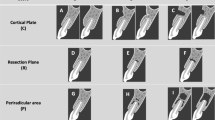Abstract
Objectives
(1) To evaluate the effectiveness of the static-guided (SG) endodontics technique for accessing the root canal through the mineral trioxide aggregate (MTA) and (2) to evaluate the effect of this technique on the fracture strength of teeth.
Materials and methods
Thirty mandibular premolars were used in the present study. After standard coronal access cavity preparation, root canals were prepared up to size #80 to simulate an immature root apex. White MTA was placed approximately 3 mm below the cementoenamel junction (CEJ), as placed in regenerative endodontic procedures. After the MTA had set, the cavity was restored with a resin composite material. The teeth were randomly divided into two groups (n = 15). In the control group, the composite resin and MTA were removed without any guide. In the SG-access group, a cone beam computed tomography (CBCT) scan was performed, 3D-printed guides were designed and fabricated, and then the composite resin and MTA were removed with a guide. One inexperienced operator performed the removal of the composite resin and MTA in all groups. Pre- and post-operative periapical radiographs were taken. The mishaps and time to penetration to root canal were recorded. After that, the root canals were filled, and the access cavities were restored. The samples were subjected to a fracture strength test. Data were analyzed using Mann-Whitney U, independent samples of T test, and chi-square tests at 95% confidence level (P = 0.05).
Results
There were significant differences between the control and SG-access groups in terms of mishaps and time to penetration to the root canal through the MTA barrier (P < 0.05). The SG-access group required the shorter time as compared with the control group. Mishaps did not occur in the SG-access group. The SG-access group exhibited the significantly preserved fracture resistance of the teeth as compared with the control group (P < 0.05). Non-restorable failure occurred more frequently in the control group than in the SG-access group.
Conclusions
Within the limitations of the present study, the SG endodontic technique yielded favorable results with respect to time, mishaps, and fracture strength.
Clinical relevance
The static-guided endodontics technique may provide advantages to the clinician for MTA removal.



Similar content being viewed by others
References
Li L, Pan Y, Mei L, Li J (2017) Clinical and radiographic outcomes in immature permanent necrotic evaginated teeth treated with regenerative endodontic procedures. J Endod 43:246–251
Jeeruphan T, Jantarat J, Yanpiset K, Suwannapan L, Khewsawai P, Hargreaves KM (2012) Mahidol study 1: comparison of radiographic and survival outcomes of immature teeth treated with either regenerative endodontic or apexification methods: a retrospective study. J Endod 38:1330–1336
Ostby BN (1961) The role of the blood clot in endodontic therapy. An experimental histologic study. Acta Odontol Scand 19:324–353
Meschi N, EzEldeen M, Torres Garcia AE, Jacobs R, Lambrechts P (2018) A retrospective case series in regenerative endodontics: trend analysis based on clinical evaluation and 2- and 3-dimensional radiology. J Endod 44:1517–1525
Arslan H, Ahmed HMA, Sahin Y et al (2019) Regenerative endodontic procedures in necrotic mature teeth with periapical radiolucencies: a preliminary randomized clinical study. J Endod 45:863–872
Paryani K, Kim SG (2013) Regenerative endodontic treatment of permanent teeth after completion of root development: a report of 2 cases. J Endod 39:929–934
Saoud TM, Sigurdsson A, Rosenberg PA et al (2014) Treatment of a large cystlike inflammatory periapical lesion associated with mature necrotic teeth using regenerative endodontic therapy. J Endod 40:2081–2086
Saoud TM, Martin G, Chen Y-HM, Chen KL, Chen CA, Songtrakul K, Malek M, Sigurdsson A, Lin LM (2016) Treatment of mature permanent teeth with necrotic pulps and apical periodontitis using regenerative endodontic procedures: a case series. J Endod 42:57–65
Shimizu E, Ricucci D, Albert J, Alobaid AS, Gibbs JL, Huang GTJ, Lin LM (2013) Clinical, radiographic, and histological observation of a human immature permanent tooth with chronic apical abscess after revitalization treatment. J Endod 39:1078–1083
Becerra P, Ricucci D, Loghin S, Gibbs JL, Lin LM (2014) Histologic study of a human immature permanent premolar with chronic apical abscess after revascularization/revitalization. J Endod 40:133–139
Martin G, Ricucci D, Gibbs JL, Lin LM (2013) Histological findings of revascularized/revitalized immature permanent molar with apical periodontitis using platelet-rich plasma. J Endod 39:138–144
Arslan H, Şahin Y, Topçuoğlu HS, Gündoğdu B. Histologic evaluation of regenerated tissues in the pulp spaces of teeth with mature roots at the time of the regenerative endodontic procedures. J Endod 2019 (ahead of print)
Trope M, Ray HL Jr (1992) Resistance to fracture of endodontically treated roots. Oral Surg Oral Med Oral Pathol 73:99–102
Schiavetti R, Sannino G (2012) In vitro evaluation of ferrule effect and depth of post insertion on fracture resistance of fiber posts. Comput Math Methods Med 2012:816481
Uzunoglu E, Aktemur S, Uyanik MO, Durmaz V, Nagas E (2012) Effect of ethylenediaminetetraacetic acid on root fracture with respect to concentration at different time exposures. J Endod 38:1110–1113
Topcuoglu HS, Arslan H, Keles A, Koseoglu M (2012) Fracture resistance of roots filled with three different obturation techniques. Med Oral Patol Oral Cir Bucal 17:e528–e532
Tang W, Wu Y, Smales RJ (2010) Identifying and reducing risks for potential fractures in endodontically treated teeth. J Endod 36:609–617
Torres A, Shaheen E, Lambrechts P, Politis C, Jacobs R (2019) Microguided endodontics: a case report of a maxillary lateral incisor with pulp canal obliteration and apical periodontitis. Int Endod J 52:540–549
Byun C, Kim C, Cho S, Baek SH, Kim G, Kim SG, Kim SY (2015) Endodontic treatment of an anomalous anterior tooth with the aid of a 3-dimensional printed physical tooth model. J Endod 41:961–965
Perez C, Finelle G, Couvrechel C. Optimisation of a guided endodontics protocol for removal of fibre-reinforced posts. Aust Endod J 2019 (ahead of print).
Mena-Alvarez J, Rico-Romano C, Lobo-Galindo AB, Zubizarreta-Macho A (2017) Endodontic treatment of dens evaginatus by performing a splint guided access cavity. J Esthet Restor Dent 29:396–402
Connert T, Zehnder MS, Amato M, Weiger R, Kühl S, Krastl G (2018) Microguided endodontics: a method to achieve minimally invasive access cavity preparation and root canal location in mandibular incisors using a novel computer-guided technique. Int Endod J 51:247–255
Strbac GD, Schnappauf A, Giannis K, Moritz A, Ulm C (2017) Guided modern endodontic surgery: a novel approach for guided osteotomy and root resection. J Endod 43:496–501
Ding RY, Cheung GS, Chen J, Yin XZ, Wang QQ, Zhang CF (2009) Pulp revascularization of immature teeth with apical periodontitis: a clinical study. J Endod 35:745–749
Trope M (2010) Treatment of the immature tooth with a non-vital pulp and apical periodontitis. Dent Clin N Am 54:313–324
Silujjai J, Linsuwanont P (2017) Treatment outcomes of apexification or revascularization in nonvital immature permanent teeth: a retrospective study. J Endod 43:238–245
Shah N, Logani A (2012) SealBio: A novel, non-obturation endodontic treatment based on concept of regeneration. J Conserv Dent 15:328–332
Buchgreitz J, Buchgreitz M, Mortensen D, Bjorndal L (2016) Guided access cavity preparation using cone-beam computed tomography and optical surface scans - an ex vivo study. Int Endod J 49:790–795
Zehnder MS, Connert T, Weiger R, Krastl G, Kühl S (2016) Guided endodontics: accuracy of a novel method for guided access cavity preparation and root canal location. Int Endod J 49:966–972
Connert T, Krug R, Eggmann F et al (2019) Guided endodontics versus conventional access cavity preparation: a comparative study on substance loss using 3-dimensional-printed teeth. J Endod 45:327–331
Sahafi A, Peutzfeldt A, Ravnholt G, Asmussen E, Gotfredsen K (2005) Resistance to cyclic loading of teeth restored with posts. Clin Oral Investig 9:84–90
Krastl G, Zehnder MS, Connert T, Weiger R, Kühl S (2016) Guided Endodontics: a novel treatment approach for teeth with pulp canal calcification and apical pathology. Dent Traumatol 32:240–246
Connert T, Zehnder MS, Weiger R, Kühl S, Krastl G (2017) Microguided endodontics: accuracy of a miniaturized technique for apically extended access cavity preparation in anterior teeth. J Endod 43:787–790
Ulusoy Ö, Nayır Y, Darendeliler S (2011) Effect of different root canal sealers on fracture strength of simulated immature roots. Oral Surg Oral Med Oral Pathol Oral Radiol Endod 112:544–547
Author information
Authors and Affiliations
Corresponding author
Ethics declarations
Conflict of interest
The authors declare that they have no conflict of interest.
Ethical approval
The research described in this article did not involve human participants or animals.
Additional information
Publisher’s note
Springer Nature remains neutral with regard to jurisdictional claims in published maps and institutional affiliations.
Rights and permissions
About this article
Cite this article
Ali, A., Arslan, H. Effectiveness of the static-guided endodontic technique for accessing the root canal through MTA and its effect on fracture strength. Clin Oral Invest 25, 1989–1995 (2021). https://doi.org/10.1007/s00784-020-03507-x
Received:
Accepted:
Published:
Issue Date:
DOI: https://doi.org/10.1007/s00784-020-03507-x




